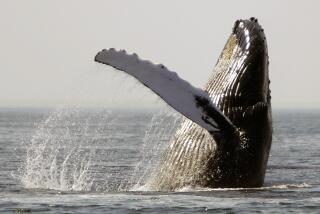Shell Study Suggests Rapid Change in Sea Temperature
- Share via
BOSTON — Study of the chemistry of crustacean shells suggests that ocean temperatures can fluctuate dramatically in shorter times than once believed, researchers say.
Ocean temperatures strongly influence rainfall, fish and other species, and even sea level.
“There are some sites that are very sensitive to change, and they can affect us humans,” said Patrick De Deckker, a geologist at the Australian National University, in Canberra.
He collaborated with Gary Dwyer, a geologist at Duke University, and other geologists and chemists. They spoke June 2 at a meeting of the American Geophysical Union, which brings together climatologists, geologists and other Earth scientists.
The shell researchers are developing a new field of study by scooping up layers of sediment from the ocean floor and studying the shell chemistry of microscopic prawns known as ostracods.
Dwyer, who studied a site about 3,000 feet deep off the Bahama Islands, found that the ratio of magnesium to calcium in the shells suggests that the animals lived in temperatures varying up to 10 degrees Fahrenheit, from a high of 47 about 9,000 years ago to a low of 37 about 3,500 years later. He said the results, if borne out by further research, “would be a surprise to a lot of people” who study the oceans.
Some other researchers using other techniques have hypothesized more modest fluctuations.
However, Ruth Curry, an oceanographer at Woods Hole Oceanographic Institution, said research has increasingly pointed to large shifts in Earth’s climate within thousands or even hundreds of years.
She said such work is helping to establish a norm against which to judge contemporary changes. “Is there a threshold beyond which we kick the system--and it can’t come back?” she asked.






